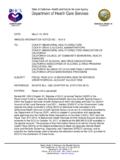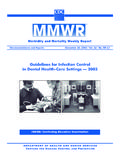Transcription of Revised Recommendations for HIV Testing of …
1 Morbidity and Mortality Weekly ReportRecommendations and ReportsSeptember 22, 2006 / Vol. 55 / No. RR-14 INSIDE: Continuing Education Examinationdepardepardepardepardepartmen t of health and human sertment of health and human sertment of health and human sertment of health and human sertment of health and human servicesvicesvicesvicesvicesCenters for Disease Control and PreventionCenters for Disease Control and PreventionCenters for Disease Control and PreventionCenters for Disease Control and PreventionCenters for Disease Control and PreventionRevised Recommendations for HIV Testingof Adults, Adolescents, and Pregnant Womenin Health-Care SettingsMMWRCONTENTSI ntroduction .. 2 Background .. 2 Evolution of HIV Testing Recommendations in Health-CareSettings and for Pregnant 2 Rationale for Screening for HIV 4 Rationale for New 4 Recommendations for Adults and 7 Screening for HIV 7 Repeat 7 Consent and Pretest 7 Diagnostic Testing for HIV 8 Similarities and Differences Between Current and PreviousRecommendations for Adults and 8 Recommendations for Pregnant 8 HIV Screening for Pregnant Women and Their 9 Similarities and Differences Between Current andPrevious Recommendations for Pregnant Womenand Their Infants.
2 10 Additional Considerations for HIV 10 Test Results .. 10 Clinical Care for HIV-Infected 11 Partner Counseling and 11 Special Considerations for Screening 11 Prevention Services for HIV-Negative 12 HIV/AIDS 12 Monitoring and 12 Primary Prevention and HIV Testing in Nonclinical Settings . 12 Regulatory and Legal 13 Other 13 Centers for Disease Control and PreventionJulie L. Gerberding, MD, MPHD irectorTanja Popovic, MD, PhD(Acting) Chief Science OfficerJames W. Stephens, PhD(Acting) Associate Director for ScienceSteven L. Solomon, MDDirector, Coordinating Center for Health Information and ServiceJay M. Bernhardt, PhD, MPHD irector, National Center for Health MarketingJudith R. Aguilar(Acting) Director, Division of Health Information Dissemination (Proposed)Editorial and Production StaffEric E.
3 Mast, MD(Acting) Editor, MMWR SeriesSuzanne M. Hewitt, MPAM anaging Editor, MMWR SeriesTeresa F. RutledgeLead Technical Writer-EditorJeffrey D. Sokolow, MAProject EditorBeverly J. HollandLead Visual Information SpecialistLynda G. CupellVisual Information SpecialistQuang M. Doan, MBAE rica R. ShaverInformation Technology SpecialistsDisclosure of RelationshipCDC, our planners, and our content experts wish to disclose they haveno financial interests or other relationships with the manufacturers ofcommercial products, suppliers of commercial services, or commercialsupporters. Presentations will not include any discussion of the unlabeleduse of a product or a product under investigational BoardWilliam L. Roper, MD, MPH, Chapel Hill, NC, ChairmanVirginia A. Caine, MD, Indianapolis, INDavid W. Fleming, MD, Seattle, WAWilliam E.
4 Halperin, MD, DrPH, MPH, Newark, NJMargaret A. Hamburg, MD, Washington, DCKing K. Holmes, MD, PhD, Seattle, WADeborah Holtzman, PhD, Atlanta, GAJohn K. Iglehart, Bethesda, MDDennis G. Maki, MD, Madison, WISue Mallonee, MPH, Oklahoma City, OKStanley A. Plotkin, MD, Doylestown, PAPatricia Quinlisk, MD, MPH, Des Moines, IAPatrick L. Remington, MD, MPH, Madison, WIBarbara K. Rimer, DrPH, Chapel Hill, NCJohn V. Rullan, MD, MPH, San Juan, PRAnne Schuchat, MD, Atlanta, GADixie E. Snider, MD, MPH, Atlanta, GAJohn W. Ward, MD, Atlanta, GAThe MMWR series of publications is published by the CoordinatingCenter for Health Information and Service, Centers for DiseaseControl and Prevention (CDC), Department of Health andHuman Services, Atlanta, GA Citation: Centers for Disease Control and Prevention.
5 [Title]. MMWR 2006;55(No. RR-14):[inclusive page numbers].Vol. 55 / RR-14 Recommendations and Reports1 The material in this report originated in the National Center forHIV/AIDS, Viral Hepatitis, STD, and TB Prevention (proposed),Kevin A. Fenton, MD, PhD, Director; and the Division of HIV/AIDS Prevention, Timothy D. Mastro, MD, (Acting) preparer: Bernard M. Branson, MD, Division of HIV/AIDS Prevention, National Center for HIV/AIDS, Viral Hepatitis,STD, and TB Prevention (proposed), 1600 Clifton Road, ,MS D-21, Atlanta, GA 30333. Telephone: 404-639-0900; Fax: 404-639-0897; E-mail: Recommendations for HIV Testingof Adults, Adolescents, and Pregnant Womenin Health-Care SettingsPrepared byBernard M. Branson, MD1H. Hunter Handsfield, MD2 Margaret A. Lampe, MPH1 Robert S.
6 Janssen, MD1 Allan W. Taylor, MD1 Sheryl B. Lyss, MD1 Jill E. Clark, MPH31 Division of HIV/AIDS Prevention, National Center for HIV/AIDS, Viral Hepatitis, STD, and TB Prevention (proposed)2 Division of STD Prevention, National Center for HIV/AIDS, Viral Hepatitis, STD, and TB Prevention (proposed) and University of Washington, Seattle, Washington3 Northrup Grumman Information Technology (contractor with CDC)SummaryThese Recommendations for human immunodeficiency virus (HIV) Testing are intended for all health-care providers in thepublic and private sectors, including those working in hospital emergency departments, urgent care clinics, inpatient services,substance abuse treatment clinics, public health clinics, community clinics, correctional health-care facilities, and primary caresettings. The Recommendations address HIV Testing in health-care settings only.
7 They do not modify existing guidelines concerningHIV counseling, Testing , and referral for persons at high risk for HIV who seek or receive HIV Testing in nonclinical settings ( ,community-based organizations, outreach settings, or mobile vans). The objectives of these Recommendations are to increaseHIV screening of patients, including pregnant women, in health-care settings; foster earlier detection of HIV infection;identify and counsel persons with unrecognized HIV infection and link them to clinical and prevention services; and furtherreduce perinatal transmission of HIV in the United States. These Revised Recommendations update previous Recommendations forHIV Testing in health-care settings and for screening of pregnant women (CDC. Recommendations for HIV Testing servicesfor inpatients and outpatients in acute-care hospital settings.)
8 MMWR 1993;42[No. RR-2]:1 10; CDC. Revised guide-lines for HIV counseling, Testing , and referral. MMWR 2001;50[No. RR-19]:1 62; and CDC. Revised recommenda-tions for HIV screening of pregnant women. MMWR 2001;50[No. RR-19]:63 85).Major revisions from previously published guidelines are as follows:For patients in all health-care settings HIV screening is recommended for patients in all health-care settings after the patient is notified that Testing will beperformed unless the patient declines (opt-out screening). Persons at high risk for HIV infection should be screened for HIV at least annually. Separate written consent for HIV Testing should not be required; general consent for medical care should be consideredsufficient to encompass consent for HIV Testing . Prevention counseling should not be required with HIV diagnostic Testing or as part of HIV screening programs inhealth-care pregnant women HIV screening should be included in the routine panel of prenatal screening tests for all pregnant women.
9 HIV screening is recommended after the patient is notified that Testing will be performed unless the patient declines(opt-out screening). Separate written consent for HIV Testing should notbe required; general consent for medical care shouldbe considered sufficient to encompass consent for HIVtesting. Repeat screening in the third trimester is recommendedin certain jurisdictions with elevated rates of HIVinfection among pregnant 22, 2006 IntroductionHuman immunodeficiency virus (HIV) infection andacquired immunodeficiency syndrome (AIDS) remain lead-ing causes of illness and death in the United States. As ofDecember 2004, an estimated 944,306 persons had receiveda diagnosis of AIDS, and of these, 529,113 (56%) had died(1). The annual number of AIDS cases and deaths declinedsubstantially after 1994 but stabilized during 1999 2004 (1).
10 However, since 1994, the annual number of cases amongblacks, members of other racial/ethnic minority populations,and persons exposed through heterosexual contact hasincreased. The number of children reported with AIDS attributed to perinatal HIV transmission peaked at 945 in1992 and declined 95% to 48 in 2004 (1), primarily becauseof the identification of HIV-infected pregnant women andthe effectiveness of antiretroviral prophylaxis in reducingmother-to-child transmission of HIV (2).By 2002, an estimated 38% 44% of all adults in the UnitedStates had been tested for HIV; 16 22 million persons aged18 64 years are tested annually for HIV (3). However, at theend of 2003, of the approximately million personsestimated to be living with HIV in the United States, an esti-mated one quarter (252,000 312,000 persons) were unawareof their infection and therefore unable to benefit from clinicalcare to reduce morbidity and mortality (4).














